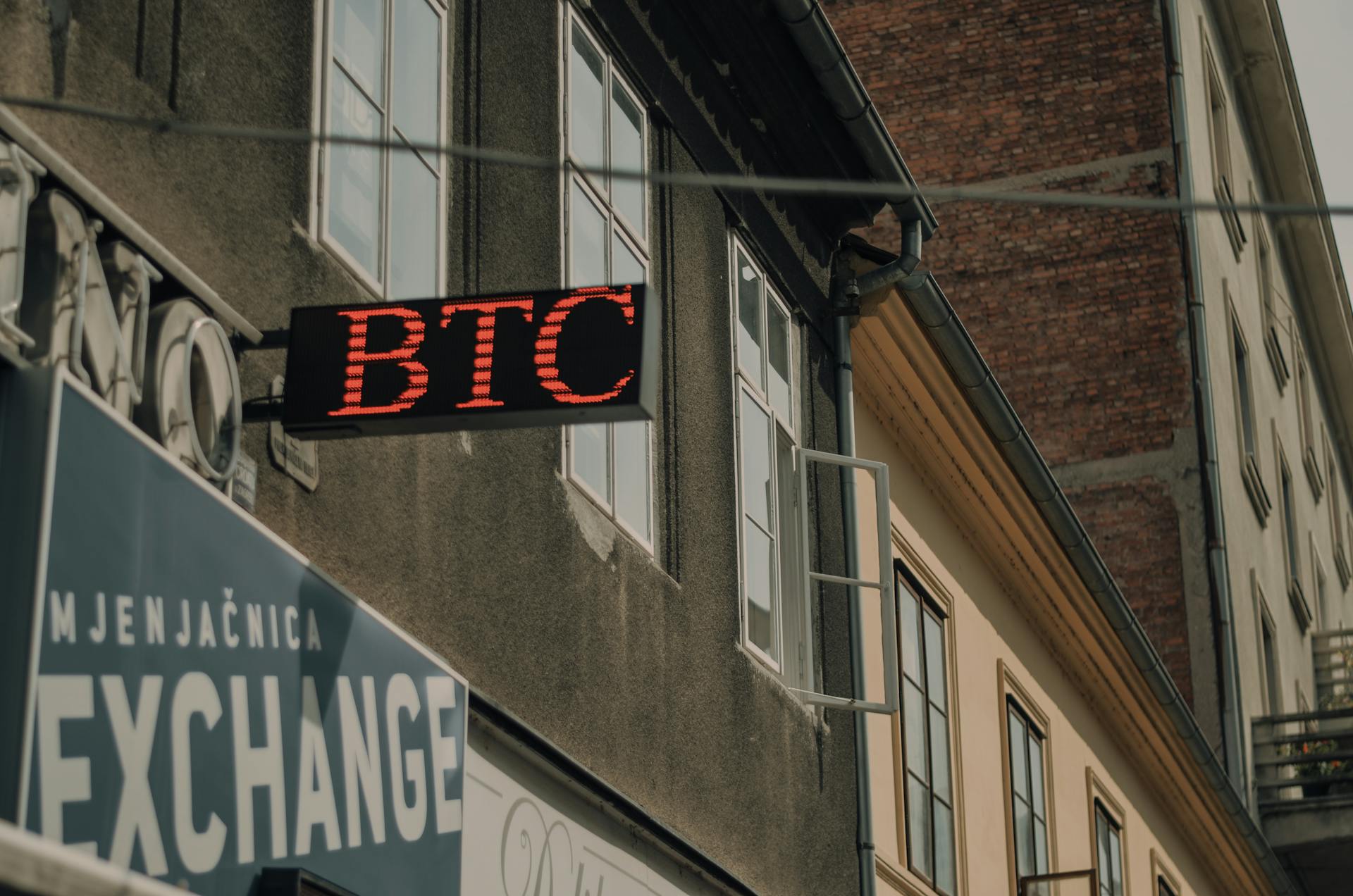
Bitstamp offers a variety of order types to help you execute trades effectively.
Market orders are executed at the current market price, with no guarantee of a specific price.
Limit orders allow you to set a specific price, and they will be executed when that price is reached.
You can also use stop-loss orders to limit potential losses by automatically closing a trade when a certain price is reached.
For more insights, see: Walmart and Money Orders
Order Types
Order types on Bitstamp are designed to help you trade with precision and control. A market order is an instruction to buy or sell an asset immediately at the current market price. This order type is popular among traders who want to capitalize on immediate market movements.
Market orders can sometimes result in unexpected outcomes if the market experiences rapid price fluctuations. To mitigate this risk, Bitstamp offers features that help protect your investments, even in volatile market conditions.
A limit order, on the other hand, enables you to specify your desired maximum buy price or minimum sell price. This order type grants control over transaction prices, but it doesn't guarantee that the trade will occur. Limit orders are particularly advantageous for those who wish to manage and possibly mitigate risks associated with changing security prices.
Suggestion: Types of Equity Market
Here are the common order types on Bitstamp:
- Instant order: Determine your buying/selling price in fiat.
- Market order: Determine your buying/selling price in crypto.
- Limit order: Determine both the price and the amount.
- Stop order: Determine the exit or entry point.
- Trailing stop order: Create a movable exit or entry point.
A pegged order is a type of order where the price is dynamically adjusted based on a reference point, such as the best bid or ask price, the midpoint of the bid-ask spread, or the last traded price. This order type automatically adjusts the order price in response to market conditions, allowing traders to maintain a competitive position relative to the prevailing market price.
Explore further: Types of Money Market
Terminology
Buying and selling are the two fundamental actions in trading. Buying means obtaining assets by exchanging them for another medium of value, such as fiat currency. Selling is the opposite, relinquishing assets in exchange for a return of value.
Trading can be performed at the market price, which varies based on demand among market participants. A market order is a type of order that allows you to buy or sell an asset immediately at the current market price.
Here's an interesting read: Forex Day Trader
A limit order, on the other hand, is a type of order that allows you to specify the price at which you're willing to buy or sell an asset. This order type favors the accuracy of execution price over the expediency of the trade's execution.
Here's a quick rundown of common order types:
Understanding these order types can help you make informed decisions in your trading journey.
Fill or Kill
Fill or Kill orders are typically used when traders want to ensure that their entire order is executed swiftly or not executed at all.
A Fill or Kill order in trading mandates immediate and complete execution of the entire order quantity at the specified price or better.
If the order cannot be filled immediately, it is canceled, which is why this order type helps prevent partial fills.
All or None
An All or None (AON) order requires the entire order to be filled at once, or it won't be filled at all.
This order type is particularly useful for traders who want to ensure they receive the full quantity they desire in a single transaction.
Unlike a Fill or Kill order, an AON order allows for the order to be filled over time as long as the entire quantity is eventually executed.
A trader might use an AON order to guarantee they get the full amount of shares they want, rather than risking partial fills.
Oco
An OCO order is a type of order where the execution of one part of the order automatically cancels the other part. It consists of two orders: a primary order and a secondary order.
This type of order is commonly used by traders who want to simultaneously set both a stop-loss order and a take-profit order for a given position.
The other order is automatically canceled if the primary or secondary order is executed. This means that if one of the orders is filled, the other one is immediately canceled.
OCO orders can be a useful tool for managing risk and securing profits, but they do require careful consideration and planning to set up effectively.
Broaden your view: Limit Orders
What Is a Trade?
A trade is essentially an instruction given by an investor to a brokerage firm or broker to buy or sell a security. This can be done via phone call, online through trading platforms, or even through automated systems and algorithmic trading.
Placing a trade order is similar to ordering food at a restaurant, where you direct your broker to buy or sell a security on your behalf.
Recommended read: How to Sell Cash Secured Puts on Webull
Stop-Limit
A stop-limit order is a type of trading order that combines elements of a stop order and a limit order. It consists of two key price points: the stop price and the limit price.
The stop price is the price at which the order becomes a limit order, and it will only be executed at the specified limit price or better. This means that the order may not be filled if the limit price is not reached.
A stop-limit order is used to manage risk and protect against adverse price movements. It allows traders to specify both the price at which they are willing to sell or buy an asset (the limit price) and the price at which they want the order to be triggered (the stop price).
Here's an interesting read: Which of the following Is Not a Type of Power?
Here are some key characteristics of stop-limit orders:
- They use limit orders, which means they will only be executed at the specified limit price or better.
- They have two key price points: the stop price and the limit price.
- They may not be filled if the limit price is not reached.
A stop-limit order can be a useful tool for traders who want to manage their risk and protect against losses. By specifying both the stop price and the limit price, traders can ensure that their order is executed at a price that is favorable to them.
For another approach, see: Profitable Day Traders
Pegged
A pegged order is a type of order where the price is dynamically adjusted based on a reference point, such as the best bid or ask price, the midpoint of the bid-ask spread, or the last traded price.
Pegged orders automatically adjust the order price in response to market conditions, allowing traders to maintain a competitive position relative to the prevailing market price.
Common pegged orders include pegged-to-market orders, pegged-to-primary orders, and pegged-to-midpoint orders.
Remove
Remove is an essential aspect of trading that allows traders to adjust their plans in response to changing circumstances.
A cancel order is a request to revoke or annul a previously submitted order that has not yet been executed.
Traders may cancel an order for various reasons, such as a change in market conditions, a shift in trading strategy, or simply an error in the initial order entry.
Canceling an order effectively removes it from the order book, preventing it from being executed.
This helps traders avoid unintended trades and adjust their trading plans accordingly.
Market orders, on the other hand, allow traders to set how much crypto they want to buy or sell, while setting aside how much they are willing to pay or receive.
However, market orders can take a while to be executed, and the price can change between submission and execution.
Limit orders, which favor the accuracy of execution price over expediency, can be used to specify at what price a trader is willing to buy or sell an asset.
By canceling an order, traders can adjust their strategy and avoid potential losses.
A cancel order effectively removes the original order from the order book, preventing it from being executed.
A unique perspective: Stock Order Book
Book
The order book is a crucial part of trading, and it's where you can find all the open orders that are waiting to be executed. It's usually located at the bottom of the trading platform.
The order book is color-coded, with bids shown in green on the left and asks shown in red on the right. This makes it easy to see the different types of orders and their corresponding prices.
Each order in the book specifies the amount to be traded, the value of the order, and the total sum. For example, if you see a bid at 6931.41 USD with an amount of 4.00000000, that means the trader is buying 4 BTC at that price.
The value of the order is calculated by multiplying the bid price by the amount, so in this case, the value is 27,725.64 USD. The sum column shows the total of all the amounts combined.
Here's an interesting read: What Type of Reaction Is Shown Below?
Risk Management
Risk Management is a crucial aspect of trading, and Bitstamp offers several order types to help you manage your risk. A stop-loss order is a market order that automatically sells your asset when its price falls to a certain level, protecting you from excessive losses during volatile market conditions.
Stop-loss orders can be used to limit potential losses, and they're especially useful for traders who can't monitor the market 24/7. By setting a stop-loss order, you can ensure that you don't lose more than you're willing to risk.
A stop-loss market order is a type of stop-loss order that uses market orders to sell your asset at the current market price. This type of order is designed to favor execution speed over price.
Here are some key differences between stop-loss orders and stop-limit orders:
In the volatile crypto market, it's essential to take caution and limit losses. Stop-loss and stop-limit orders can help you do just that, and understanding how they work is crucial for responsible trading. By using these order types, you can protect your capital and make more informed trading decisions.
Frequently Asked Questions
What are crypto orders?
Crypto orders are instructions to buy or sell digital assets on a crypto exchange, executed based on market conditions and order type. They facilitate the matching of buyers and sellers, making trading possible
Sources
- https://www.bitstamp.net/learn/crypto-trading/what-are-stop-loss-and-stop-limit-orders/
- https://www.quantifiedstrategies.com/types-of-trading-orders/
- https://www.bitstamp.net/learn/crypto-trading/common-crypto-order-types/
- https://www.bitstamp.net/learn/crypto-trading/understanding-tradeview/
- https://www.quantifiedstrategies.com/market-orders-you-can-use-for-smart-trading-on-bitstamp/
Featured Images: pexels.com

